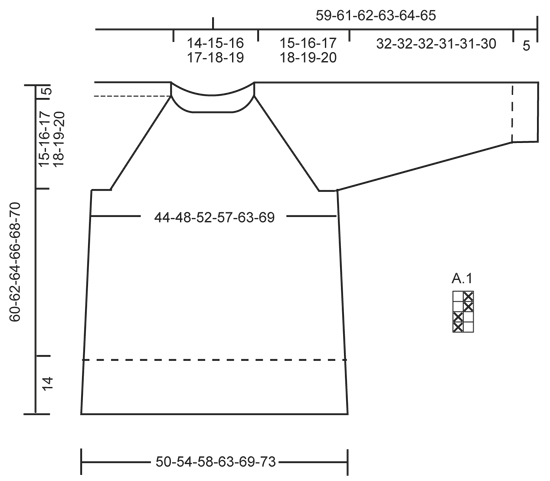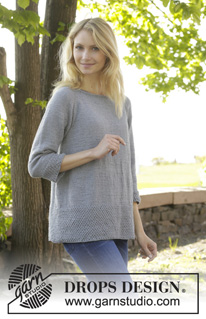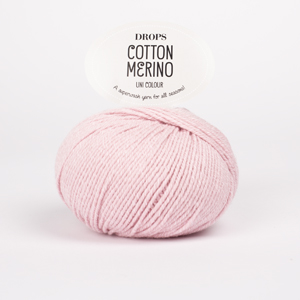Comments / Questions (46)
![]() Cornelia Lechleiter wrote:
Cornelia Lechleiter wrote:
Wenn ich bei Gr.xxl nach der Erhöhung für den Hals bei 88M angekommen bin Wende und in der Rückreihe bis zum Rd Anfang stricke Wende und weiterstricke in Runde mit rechts,dann die Maschen einteile für die Raglanärmel 32-24-64-24-32 befindet sich ein Ärmel in der Erhöhung ein Ärmel im Vorderteil. Was mach ich falsch ??? Ich habe schon 3mal alles aufgezogen 😒😒
23.01.2016 - 18:37DROPS Design answered:
Eventuell liegt hier ein Fehler in der Anleitung vor, das wird nun von den Designerinnen geprüft. Ich bitte daher noch um etwas Geduld bis zur Antwort.
02.02.2016 - 11:50
![]() Sarah wrote:
Sarah wrote:
Hallo, wenn ich den Nacken hinten länger stricke in M dann komme ich auf der einen Seite wo man 53 Maschen stricken soll schneller auf 68 als auf der anderen. Soll das so?
09.01.2016 - 11:03DROPS Design answered:
Sie beginnen ja an der hinteren Mitte und stricken 48 M. Dann wenden Sie und stricken 53 M zurück, also 5 M an der hinteren Mitte vorbei. Dann wenden Sie wieder und stricken 58 M, dann wieder wenden und 63 M stricken. Wieder wenden und 68 M str. Dann sind die verkürzten R fertig.
24.01.2016 - 13:37
![]() Inés wrote:
Inés wrote:
También quería apuntar que hay un error en la talla L: dice que vayamos tejiendo adelante y atrás añadiendo cada vez 5 puntos más hasta que hagamos 75 puntos, y deberían ser 74. Por lo demás, me encanta el patrón! Muchas gracias!
17.12.2015 - 15:40DROPS Design answered:
Hola Ines. Tienes razón. Son 74 pts. Está pasada la corrección al departamento de diseño.
19.12.2015 - 20:23
![]() Inés wrote:
Inés wrote:
El patrón parece bastante sencillo pero hay una parte que es un poco confusa: después de hacer la elevación del escote de la espalda, se ha de comenzar a contar los puntos para insertar los marcadores desde el principio de ronda "original" o desde el centro de esta elevación que hemos hecho?
17.12.2015 - 15:39DROPS Design answered:
Hola Ines. Empezamos la vuelta en el centro de la espalda para insertar los MP.
19.12.2015 - 20:27
![]() Isa wrote:
Isa wrote:
Frage zu den verkürzten Reihen im Nacken: wenn ich von der hinteren Mitte (= Reihenanfang) aus beginne und (in Gr. L) 54 M stricke, wende und 59 M stricke, wende und nun vor jedem Wenden 5 M mehr stricke befindet sich die Erhöhung nicht mittig im Nacken, sondern zum Großteil nur auf einer Seite von der hinteren Mitte. Außerdem soll die Erhöhung über insg. 75 M gestrickt werden; diese M-Zahl erreicht man aber nicht bei Zunahme von jew. 5 M - richtig wären hier wohl 74 M.
07.12.2015 - 15:34DROPS Design answered:
Sie haben Recht, dass die Erhöhung schief wird, wenn der Rd-Beginn die hintere Mitte ist, was ja so sein sollte, um den Faden nach den verkürzten R nicht abschneiden und an der hinteren Mitte neu ansetzen zu müssen. Sie müssen daher nicht 45 M zurückstricken, sondern 45 M nach dem Markierer stricken, also insgesamt 85 M zurückstricken. Dann stricken Sie immer 5 M mehr. Die Zahl 75 kann in der Tat nicht stimmen, es müssten dann 74 M ab dem Markierer sein. Ich leite beide Unstimmigkeiten an die Designerinnen weiter.
11.12.2015 - 16:19
![]() Elise wrote:
Elise wrote:
Dank je wel voor je reactie. Helaas is het nog niet duidelijk. Mijn vraag blijft nog: hoe kom je van het begin van de naald (waar je geëindigd bent na de laatste kering) naar middenachter (waar je moet beginnen met de toer met 19 steken, markeerder etc.) Begin van de naald en middenachter is nl. niet hetzelfde (zit 20 st. tussen)
18.11.2015 - 16:18DROPS Design answered:
Hoi Elise. Je breit na het laatste keerpunt terug naar het begin van de nld zoals er staat in het patroon: "...na het laatste keerpunt, keer dan en brei de teruggaande nld tot het begin van de nld." Het begin van de naald wordt vanzelf middenachter. Na de ronding plaats je vanaf middenachter (begin van de nld) de markeerders.
20.11.2015 - 10:35
![]() Elise wrote:
Elise wrote:
Bij de beschrijving van de pas staat dat je, na de ronding op het achterpand voor de hals gebreid te hebben, moet keren en dan terug moet breien tot het begin van de naald. Vervolgens brei je verder vanaf middenachter. 1.Wat wordt precies bedoeld met het begin van de naald: het oorspronkelijke begin (waar je opzet-draadje hangt)? 2. Hoe kom je bij middenachter? Breiend, of moet je daar opnieuw aanhechten (want volgens mij eindig je na de laatste kering niet bij middenachter)?
14.11.2015 - 19:25DROPS Design answered:
Hoi Elise. Het begin van de nld is niet verplaatst - het is waar je de hele tijd bent begonnen. Je breit (bijv maat S): brei 40 st, keer het werk en brei 45 st (dus 5 st verder dan begin van de nld), keer het werk en brei 50 st, keer het werk brei 55 st (je breit nu 10 st verder dan begin van de nld) en laatste keer keren en brei 60 st, keer en brei de terugg naald (verkeerde kant) terug naar het begin van de nld. Je hebt nu een verhoging middenachter. Je breit nu de nld (begin van de nld): 19 st, markeerder, 22 st (mouw), markeerder, 38 st (voorpand), markeerder, 22 st (mouw), markeerder en 19 st tot aan het begin van de nld. Ik hoop dat het nu duidelijk isa
17.11.2015 - 13:16
![]() Vanholsbeke wrote:
Vanholsbeke wrote:
Il est impossible d'imprimer les explications du modèle pull raglan 157-34 ??? C'est un autre pull qui s'affiche lors de l'impression!!! Merci de vouloir bien vérifier ... Cordialement, C Vanholsbeke
01.11.2015 - 14:57DROPS Design answered:
Bonjour Mme Vanholsbeke, un test a été réussi avec succès, c'est bien le bon modèle qui a pu être imprimé. Bon tricot!
02.11.2015 - 09:02Coral wrote:
Hi there, please help!! I have just finished my 75 stitches (for the elevation), then pattern says "turn and work back to beg of round". I have turned and now working WS, but my original starting position (beginning of the round) is not located mid back... 1. Do I work WS back to my original start position or just to ‘mid back’ or to the start of the elevation? 2.Then, do I turn and work RS for setting up the markers or keep working WS?
28.07.2015 - 00:29DROPS Design answered:
Hello Coral! You have to continue from RS and mid back to insert the markers. Happy knitting!
28.07.2015 - 16:04
![]() Stinta Ekholm wrote:
Stinta Ekholm wrote:
Hej, jag undrar från när man stickar runt på rundstickan? Är det direkt från början? Tack så mycket för en underbart fin tröja, den ska jag absolut sticka!
29.06.2015 - 13:17DROPS Design answered:
Hej. Ja det stämmer. Tröjan stickas uppirån och ned på rundst och du börjar direkt att sticka på rundsticka på oket. Lycka till!
30.06.2015 - 08:01
Come Here#comeheresweater |
|||||||
|
|
|||||||
Knitted DROPS jumper with raglan and moss st worked top down in ”Cotton Merino”. Size: S - XXXL.
DROPS 157-34 |
|||||||
|
GARTER ST (in the round on circular needle): * K 1 round and P 1 round *, repeat from *-*. 1 ridge = 2 rounds. PATTERN (double moss st vertically): See diagram A.1. The diagram shows all rows in pattern seen from RS. RAGLAN: Inc 2 sts on each side of every raglan as follows (= 16 sts inc): Inc as follows before 4 sts in stocking st and marker: K 2 in the next 2 sts (i.e. work in front and back loop of st) = 2 sts inc. Inc as follows after marker and 2 sts in stocking st: K 2 in the next 2 sts (i.e. work in front and back loop of st) = 2 sts inc. Inc 1 st on each side of every raglan as follows (= 8 sts inc): Inc as follows before 2 sts in stocking st and marker: 1 YO, 2 sts in stocking st. Inc after marker as follows: 2 sts in stocking st, 1 YO. K YOs twisted on next row to avoid holes. DECREASE TIP: Dec as follows before marker: Work until 3 sts remain before marker, K 2 tog, K 1. Dec as follows after marker: K 1, slip 1 st as if to K, K 1, psso. ---------------------------------------------------------- JUMPER: Work jumper top down on circular needle. Work sleeve in the round on circular needle/double pointed needles. YOKE: Cast on 100-106-110-114-118-122 sts on circular needle size 3.5 mm with Cotton Merino. Work 3 ridges in GARTER ST – see explanation above, AT THE SAME TIME on 1st round in 2nd ridge inc 10-14-18-22-29-35 sts evenly. Repeat inc in 3rd ridge = 120-134-146-158-176-192 sts. Switch to circular needle size 4 mm. Then work an elevation in back of neck in stocking st as follows, beg from RS Work 20-24-27-30-34-38 sts, turn, work 40-48-54-60-68-76 sts, turn. Continue back and forth over 5 sts more on every turn until 60-68-75-80-88-96 sts are worked, turn and work back to beg of round = mid back. Now work as follows from mid back: 19-22-25-28-32-36 sts in stocking st, insert a marker, 22-23-23-23-24-24 sts in stocking st, insert a marker, 38-44-50-56-64-72 sts in stocking st, insert a marker, 22-23-23-23-24-24 sts in stocking st, insert a marker, stocking st over the last 19-22-25-28-32-36 sts on round. REMEMBER THE KNITTING TENSION! On next round start inc for RAGLAN – see explanation above! Inc 2 sts on each side of every marker on every other round 1-1-1-2-2-3 times. Then inc 1 st on each side of every marker on every other round 18-19-21-21-23-23 times in total, and on every 4th round 1 time in all sizes = 288-310-338-366-400-432 sts. Piece measures 20-21-22-23-24-25 cm from shoulder. Now work as follows: Work the first 40-44-49-54-60-66 sts, slip the next 64-67-71-75-80-84 sts on a stitch holder (= sleeve), cast on 12 new sts under left sleeve (insert a marker in the middle of these new sts), work the next 80-88-98-108-120-132 sts, slip the next 64-67-71-75-80-84 sts on a stitch holder (= sleeve), cast on 12 new sts under right sleeve (insert a marker in the middle of these new sts), work the remaining 40-44-49-54-60-66 sts. NOW MEASURE THE PIECE FROM HERE. BODY: There are now 184-200-220-240-264-288 sts for body. Work in stocking st in the round. When piece measures 4 cm, inc 2 sts in each side as follows: Work until 1 st before marker, 1 YO, 2 sts in stocking st, 1 YO, continue as before over front piece until 1 st remains before next marker, 1 YO, 2 sts in stocking st, 1 YO, work the rest of round = 188-204-224-244-268-292 sts. NOTE: On next round K YOs twisted to avoid holes. Repeat inc every 2½-2½-3-3-3-3½ cm 6-6-5-5-5-4 more times = 212-228-244-264-288-308 sts. When all inc are done and piece measures 26-27-28-29-30-31 cm, continue with A.1 over all sts. When piece measures 40-41-42-43-44-45 cm, cast off with K over K and P over P. SLEEVE: Work sleeve in stocking st in the round on circular needle/double pointed needles. There are 64-67-71-75-80-84 sts for each sleeve. Slip sts from stitch holder back on circular needle/double pointed needles size 4 mm and cast on 12 new sts under sleeve = 76-79-83-87-92-96 sts. Work in stocking st in the round, AT THE SAME TIME insert a marker in the middle of the new sts under sleeve (i.e. 6 sts on each side of marker). NOW MEASURE THE PIECE FROM HERE. When piece measures 4 cm, dec 1 st on each side of marker - READ DECREASE TIP. Repeat dec approx. every 2-2-2-1½-1½-1½ cm 11-11-12-13-15-15 more times = 52-55-57-59-60-64 sts. When sleeve measures 32-32-32-31-31-30 cm, dec 0-1-1-1-0-0 sts = 52-54-56-58-60-64 sts. Continue with A.1 over all sts. Cast off when sleeve measures 37-37-37-36-36-35 cm. Work the other sleeve the same way. ASSEMBLY: Sew the holes under the sleeves. |
|||||||
Diagram explanations |
|||||||
|
|||||||
 |
|||||||
Have you finished this pattern?Tag your pictures with #dropspattern #comeheresweater or submit them to the #dropsfan gallery. Do you need help with this pattern?You'll find 25 tutorial videos, a Comments/Questions area and more by visiting the pattern on garnstudio.com. © 1982-2025 DROPS Design A/S. We reserve all rights. This document, including all its sub-sections, has copyrights. Read more about what you can do with our patterns at the bottom of each pattern on our site. |
|||||||




























































Post a comment to pattern DROPS 157-34
We would love to hear what you have to say about this pattern!
If you want to leave a question, please make sure you select the correct category in the form below, to speed up the answering process. Required fields are marked *.